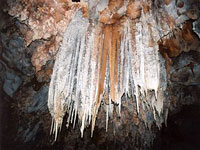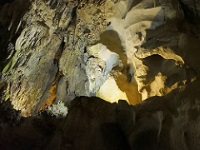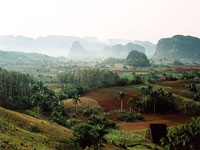Things to do in Vinales Valley
Glorious landscapes are the primary attraction of Vinales Valley, with odd round hills (magotes) and bright orange soil beneath striking greenery making the prehistoric-looking valley a unique and absorbing destination for travellers in Cuba. For a more authentic and intimate experience, tourists should avoid the tour buses and get a local guide to show them around the tobacco farms, caves and sites such as the Prehistoric Mural. Walks organised by the municipal museum allow locals to explain and show the ancient farming techniques still used by local farmers, while there is also a hop-on, hop-off bus for tourists that stops at all the main attractions in Vinales Valley.
One of the most popular things to do in Vinales is to visit the extensive and highly impressive cave systems, such as the fantastical Cueva Del Indio and the Gran Caverna De Santo Tomas. The unspoilt and authentic feel of these subterranean treasures is evident from the lack of colourful lighting or superficial decorations that so often detract from the majesty and mystery of these underground worlds.
A quick stroll down the quaint main road of the village shows visitors just how small the village is, but there are a handful of things to see and do in Vinales. The privately owned botanical garden, Jardin de las Hermanas Caridad y Carmen Miranda, is a delight, while the Centro Cultural Polo Montanez is great fun for some salsa dancing, live shows and a few tasty mojitos.

Gran Caverna de Santo Tomás
The Gran Caverna de Santo Tomás are situated about 10 miles (16km) west of Viñales. With more than 29 miles (46km) of underground galleries spanning eight different levels, it's …
Gran Caverna de Santo Tomás
The Gran Caverna de Santo Tomás are situated about 10 miles (16km) west of Viñales. With more than 29 miles (46km) of underground galleries spanning eight different levels, it's Cuba's largest cave system and one of the most important in South America. Fantastical limestone formations, glittering stalactites and stalagmites, underground lakes and vast caverns reveal themselves by the light of headlamps. Amateur spelunkers will probably be limited to just two levels, with entrances to them semi-hidden on a forested slope overlooking the valley and providing wonderful vantage points for views and photographs.

Cueva del Indio
Located in the Viñales Valley, the Cueva del Indio is a magical place. In addition to the caves, the area provides some great family activities such as hiking and climbing, as wel…
Cueva del Indio
Located in the Viñales Valley, the Cueva del Indio is a magical place. In addition to the caves, the area provides some great family activities such as hiking and climbing, as well as some gorgeous rock pools for swimming in the bright green water. The caves are named for the indigenous Guanajatabey, who carved shelters into the limestone rock to hide from Spanish colonialists. Some of their bones were unearthed in the cave system and their art is still visible on the walls. Children will love the boat ride across the underground lake in the cave, and discovering the stalactites, stalagmites and petroglyphs.

Viñales Botanical Garden
The Viñales Botanical Garden ranks highly among things to see and do in Viñales, partly because it is refreshingly intimate and unspoilt by tourists. Originally cultivated to pre…
Viñales Botanical Garden
The Viñales Botanical Garden ranks highly among things to see and do in Viñales, partly because it is refreshingly intimate and unspoilt by tourists. Originally cultivated to preserve samples of indigenous tropical plants, the garden is a riot of colour and tempered jungle that delights travellers of all ages. Gardeners are available to show visitors around and teach them about all the different species of plants, which makes for a lovely, personal experience. Roosters and chickens roam freely in the sprawling garden and there are lots of lizards and birds to marvel at too. Entrance is free but small donations are expected, particularly if visitors have taken a tour.



